Decision-making templates
Visually map strategies and allow people to hop in and leave feedback or contribute on-demand with Miro's decision-making templates collection, from Tree Diagrams to Dot Voting templates. Analyze all possible scenarios and outcomes together with your team.
69 templates
BCG Matrix Template

BCG Matrix Template
Use the BCG matrix template to make informed and strategic decisions about growth opportunities for your business. Assign your portfolio of products to different areas within the matrix (cash cows, dogs, question marks, stars) to prioritize where you should invest your time and money to see the best results.
Making Decisions
Opportunity Canvas Template

Opportunity Canvas Template
Features and capabilities — they make or break a product, which is why companies spend so much time and effort focusing on them. Sound like you? Try it with an Opportunity Canvas. This streamlined one-pager gives you and your team the power to improve your product by exploring the use cases, potential setbacks, strategies, challenges, and metrics. An Opportunity Canvas is ideal if you’ve already built a product, because you don’t need to consider the operational or revenue model.
Bull's Eye Diagram Template

Bull's Eye Diagram Template
When you’re a growing organization, every decision can feel like it has make-or-break consequences—which can lead to decision paralysis, an inability to prioritize, inefficient meetings, and even low morale. If that sounds like you, put a Bull’s Eye Diagram to work. True to its name, a Bull’s Eye Diagram uses a model of concentric circles to help companies establish priorities, make critical decisions, or discuss how to remove or overcome obstacles.
Strategic Group Mapping Template

Strategic Group Mapping Template
The Strategic Group Mapping Template is a cutting-edge visual tool designed to translate the competitive landscape of their industry. By allowing users to plot entities based on distinct criteria, this template provides an at-a-glance view of market dynamics. One standout benefit of using this tool is its ability to identify clusters of competitors and market gaps, paving the way for businesses to strategically position themselves for optimal success.
Decision-Making: Impact Over Time
Start, Stop, Continue Template

AI Accelerated
Start, Stop, Continue Template
Giving and receiving feedback can be challenging and intimidating. It’s hard to look back over a quarter or even a week and parse a set of decisions into “positive” and “negative.” The Start Stop Continue framework was created to make it easier to reflect on your team’s recent experiences. The Start Stop Continue template encourages teams to look at specific actions they should start doing, stop doing, and continue doing. Together, collaborators agree on the most important steps to be more productive and successful.
Conversion Funnel Backlog Template
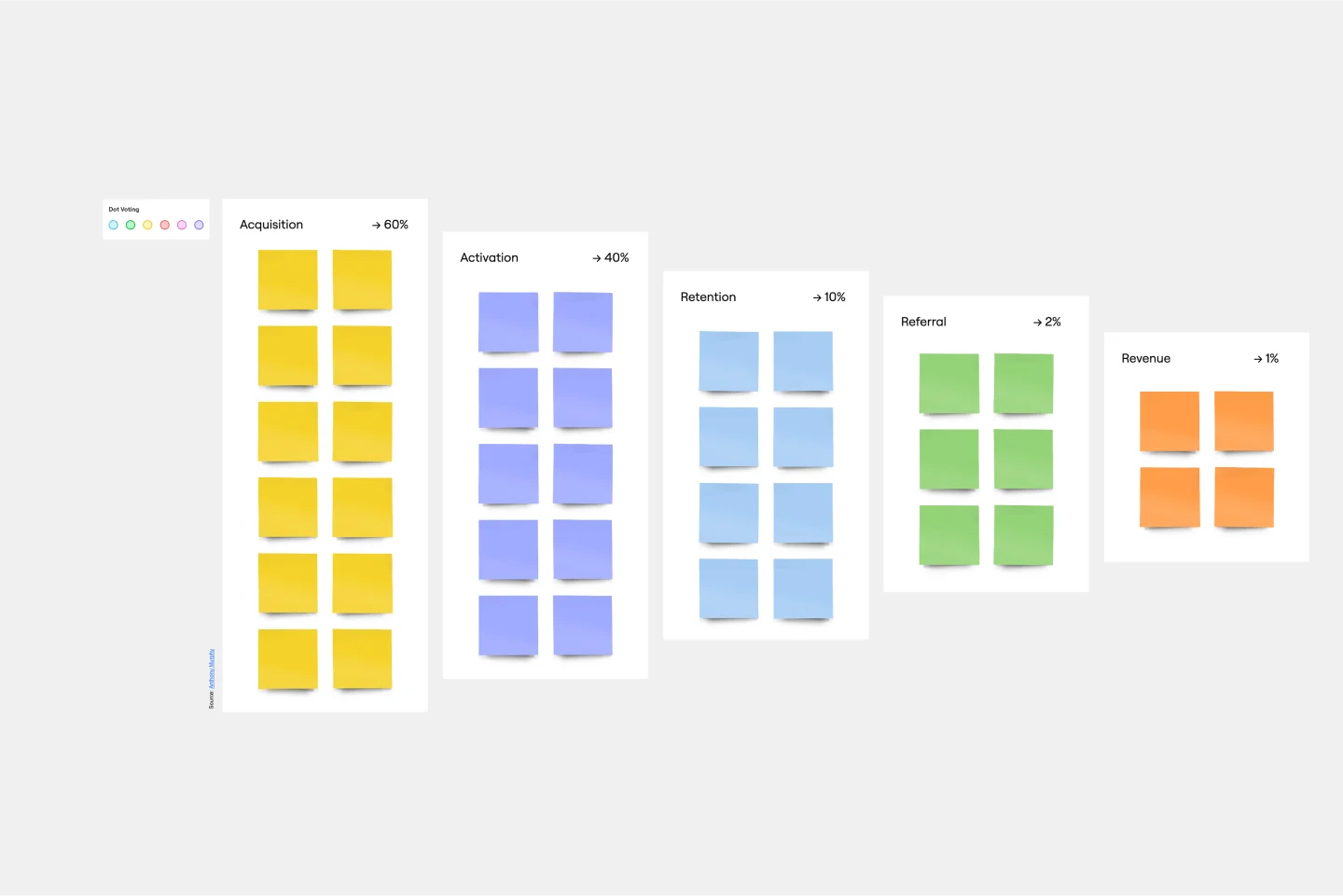
Conversion Funnel Backlog Template
If you’re working on a product that has clear conversions, then it can help to structure your backlog around the conversion funnel to make sure you’re reaching your audience. Creating a conversion funnel backlog brings together information around potential pain-points in your funnel and opportunities for growth. Once you’ve identified that information, it becomes easier to prioritize. You and your team can use the conversion funnel backlog to focus on conversion, retention, and referral, or to tweak your workflow in more mature products.
Accountability Chart Template

Accountability Chart Template
The Accountability Chart Template is a visual map detailing the various roles within an organization and the responsibilities tied to each. This systematic layout ensures clarity in defining duties and fosters a culture of accountability. A standout benefit of using this template is its capacity to eliminate role ambiguity. The Accountability Chart template ensures that every team member understands tasks by clearly depicting who is responsible for what. This leads to enhanced productivity and reduced task overlaps or missed assignments.
Influence Diagram Template
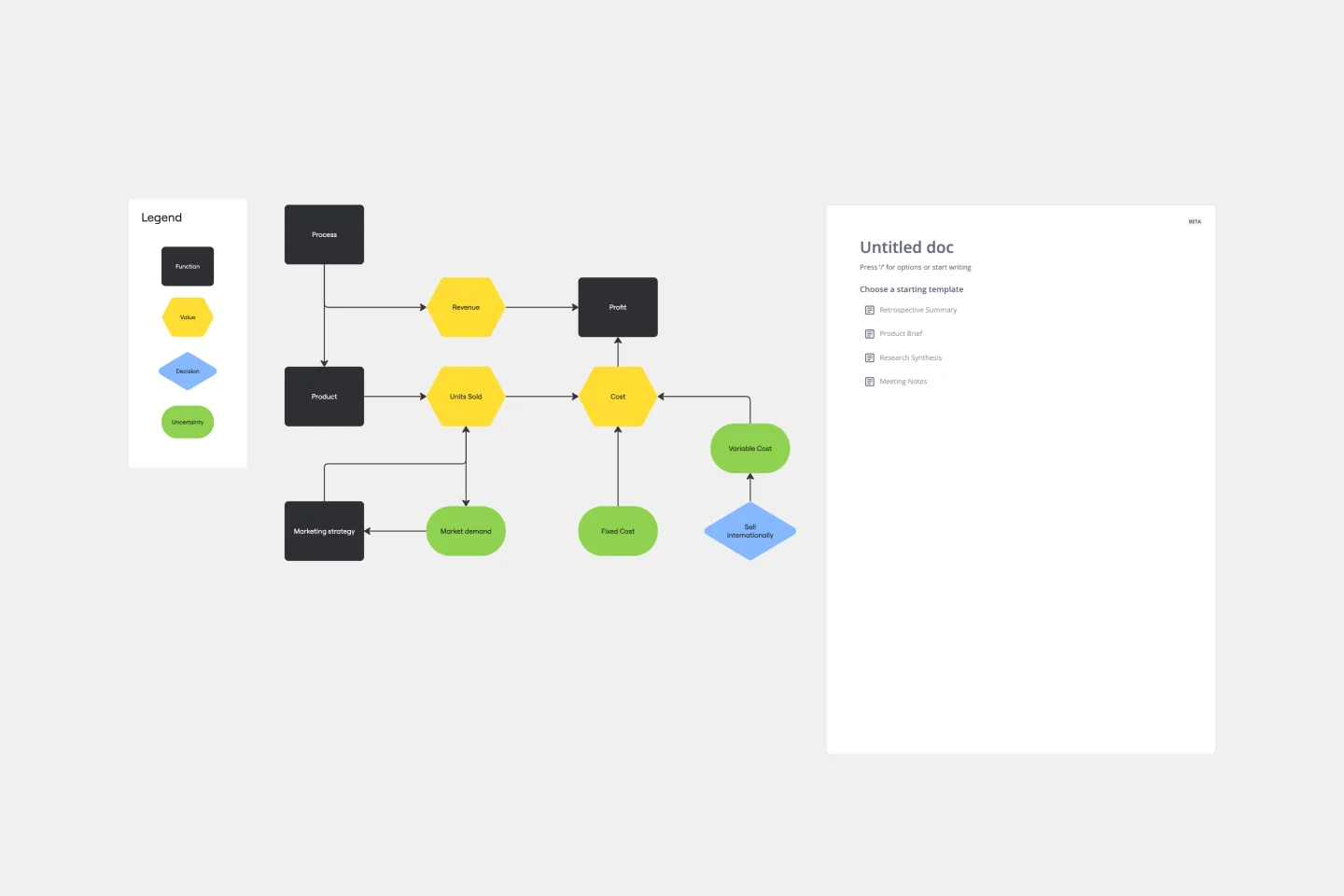
Influence Diagram Template
See the big picture of any business decision with this Influence Diagram Template. You’ll define the decision you have to make and brainstorm everything that could impact it. When you build connections between these factors, you’ll be able to put the right amount of weight into each one as you make your decision.
SOAR Analysis Template
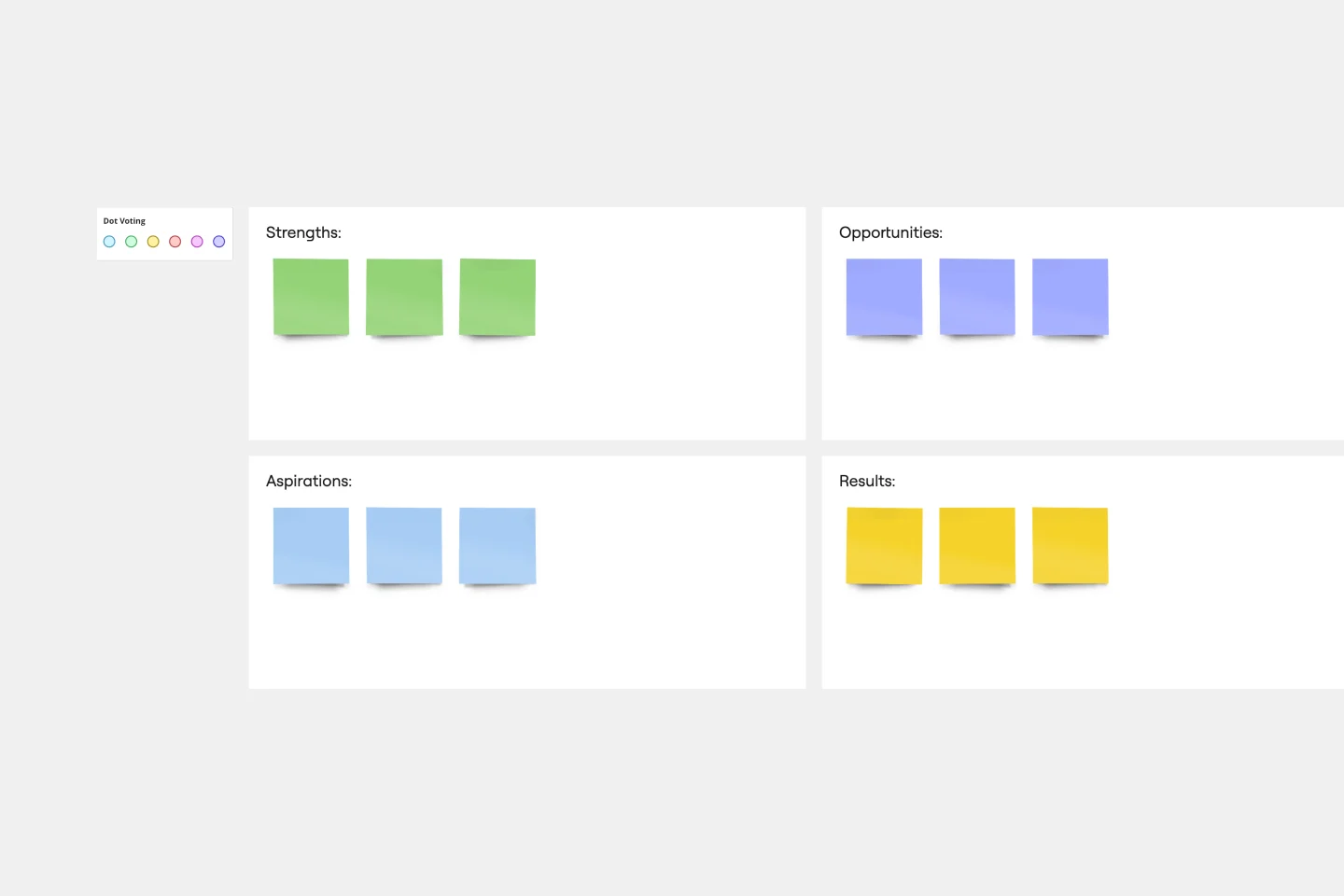
SOAR Analysis Template
The SOAR Analysis template prompts you to consider your organization’s strengths and potential to create a shared vision of the future. The SOAR Analysis is unique in that it encourages you to focus on the positive rather than solely identifying areas for growth. SOAR stands for Strengths, Opportunities, Aspirations, and Results. To use the template, examine each category through a positive lens. Perform a SOAR Analysis whenever you want to bring people together and encourage action.
IASA - Decision Bias Calibrator
PMGB Decision Workshop
4 L's Retrospective Template

AI Accelerated
4 L's Retrospective Template
So you just completed a sprint. Teams busted their humps and emotions ran high. Now take a clear-eyed look back and grade the sprint honestly—what worked, what didn’t, and what can be improved. This approach (4Ls stand for liked, learned, lacked, and longed for) is an invaluable way to remove the emotion and look at the process critically. That’s how you can build trust, improve morale, and increase engagement—as well as make adjustments to be more productive and successful in the future.
Project Scope Template
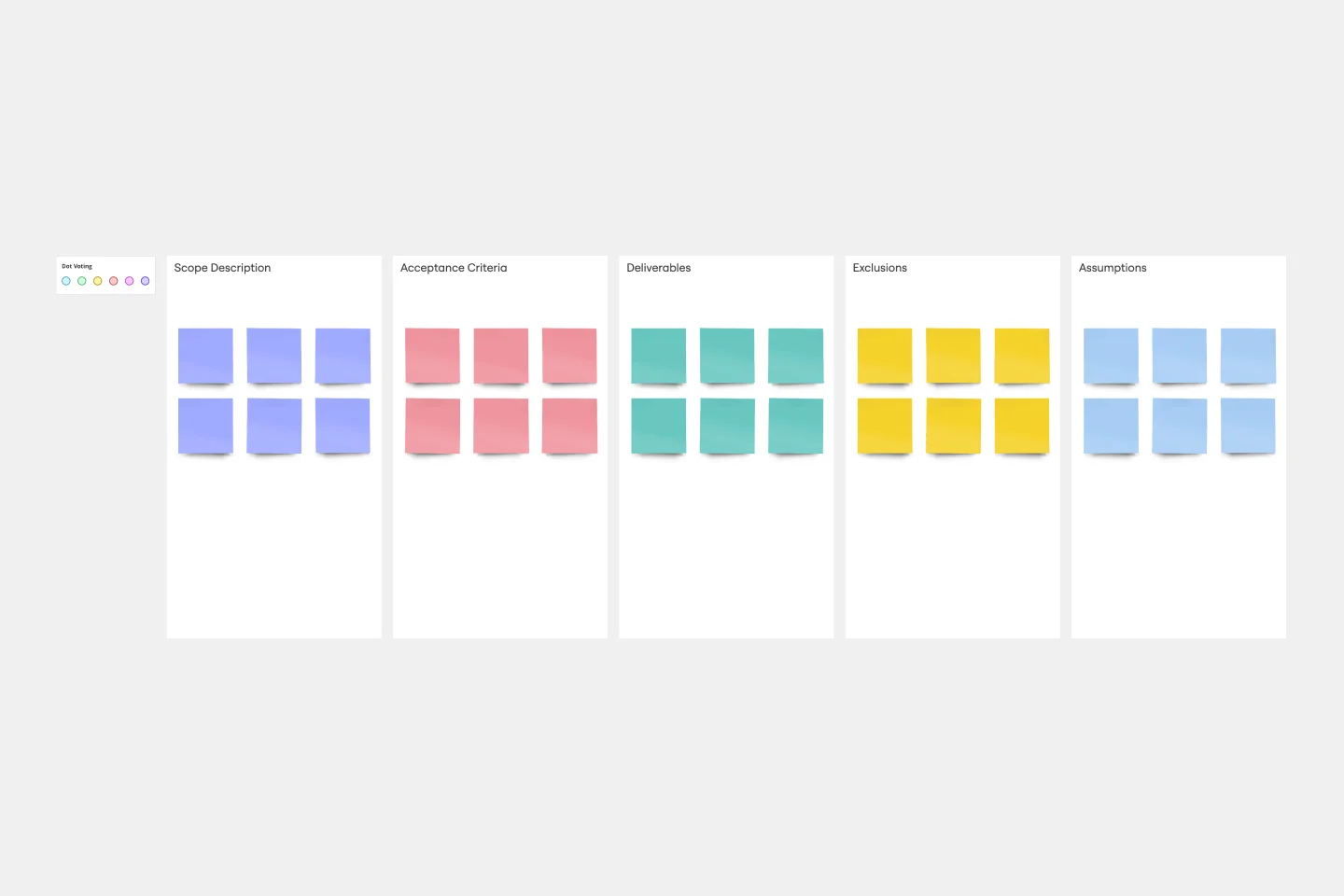
Project Scope Template
A project scope helps you plan and confirm your project’s goals, deliverables, features, functions, tasks, costs, and deadlines. A project manager and team should develop a project scope as early as possible, as it will directly influence both the schedule and cost of a project as it progresses. Though project scopes will vary depending on your team and objectives, they generally include goals, requirements, major deliverables, assumptions, and constraints. Aim to include the whole team when you create a project scope to ensure everyone is aligned on responsibilities and deadlines.
5W1H Template

5W1H Template
The 5W1H Template is a strategic framework that clarifies complex situations or projects into six foundational questions: What, Who, Where, When, How, and Why. This methodological approach ensures a comprehensive understanding, encouraging teams to dissect and explore every aspect of a given challenge or project.
Decision Matrix Template
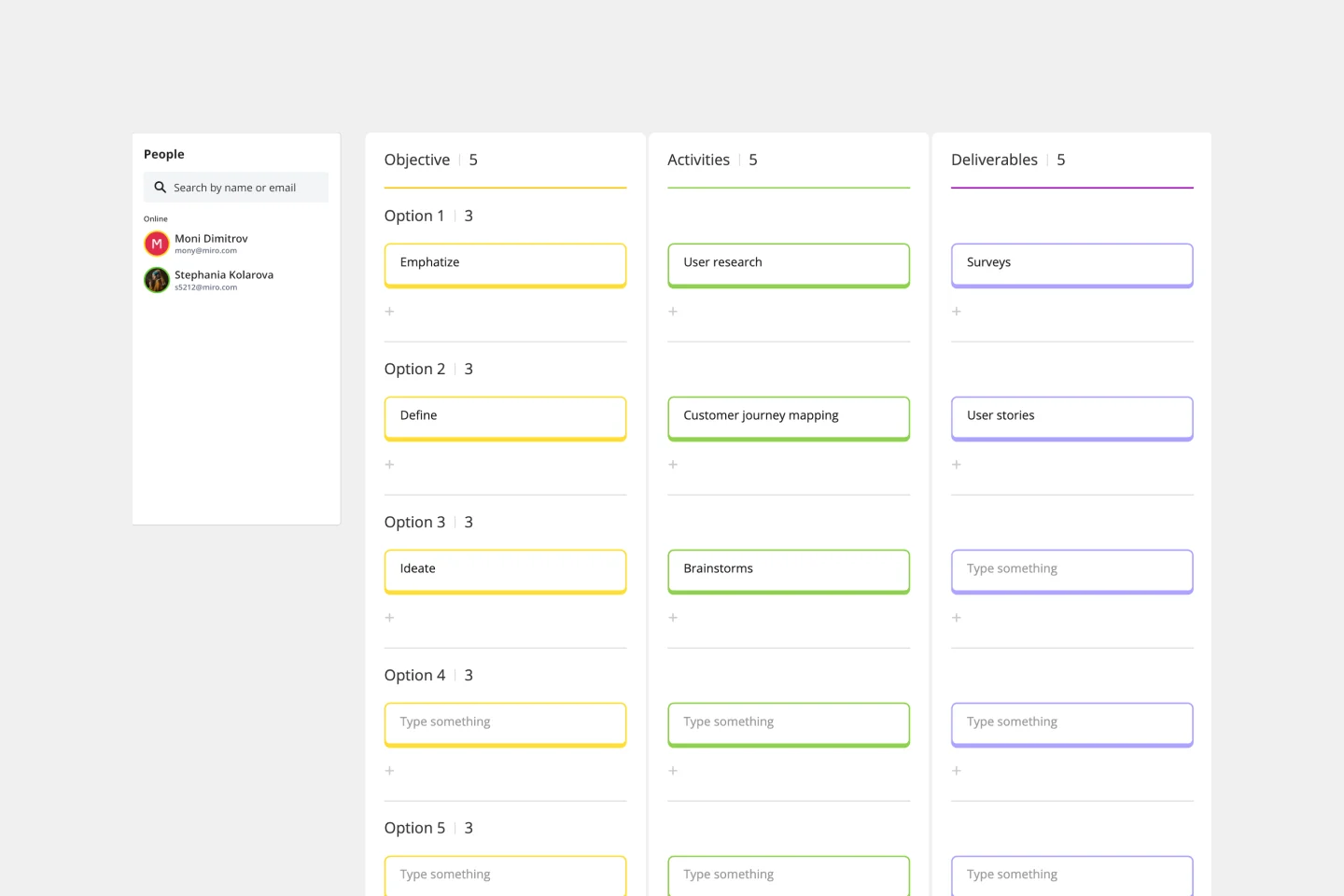
Decision Matrix Template
The Decision Matrix Template is an intuitive visual tool for structuring and evaluating multiple choices against distinct criteria. Presenting options in a comparative layout helps distill complex decisions into a digestible format.
Assumption Grid Template

Assumption Grid Template
Someone wise once said that nothing in life is certain. But the waters of the business world? It can seem especially uncertain and unclear. An Assumption Grid can help you navigate those waters and make your decisions confidently. It organizes your business ideas according to the certainty and risk of each — then your team can discuss them and make judgment calls, prioritize, mitigate risk, and overcome uncertainties. That’s why an Assumption Grid is a powerful tool for getting past the decision paralysis that every team occasionally faces.
Fibonacci Scale Template

Fibonacci Scale Template
When you manage a team, you often have to estimate how much time and effort tasks will take to complete. Try what often works for Agile teams all over the world: Turn to the Fibonacci Scale for guidance. Based on the Fibonacci sequence, where each number is the summation of the two previous numbers (0, 1, 2, 3, 5, 8, 13, 21, etc.), this template can help you build timelines like a champ—by helping make sure that work is distributed evenly and that everyone is accurate when estimating the work and time involved in a project.
Decision Analysis - Business Analysis
Fit Gap Analysis Template
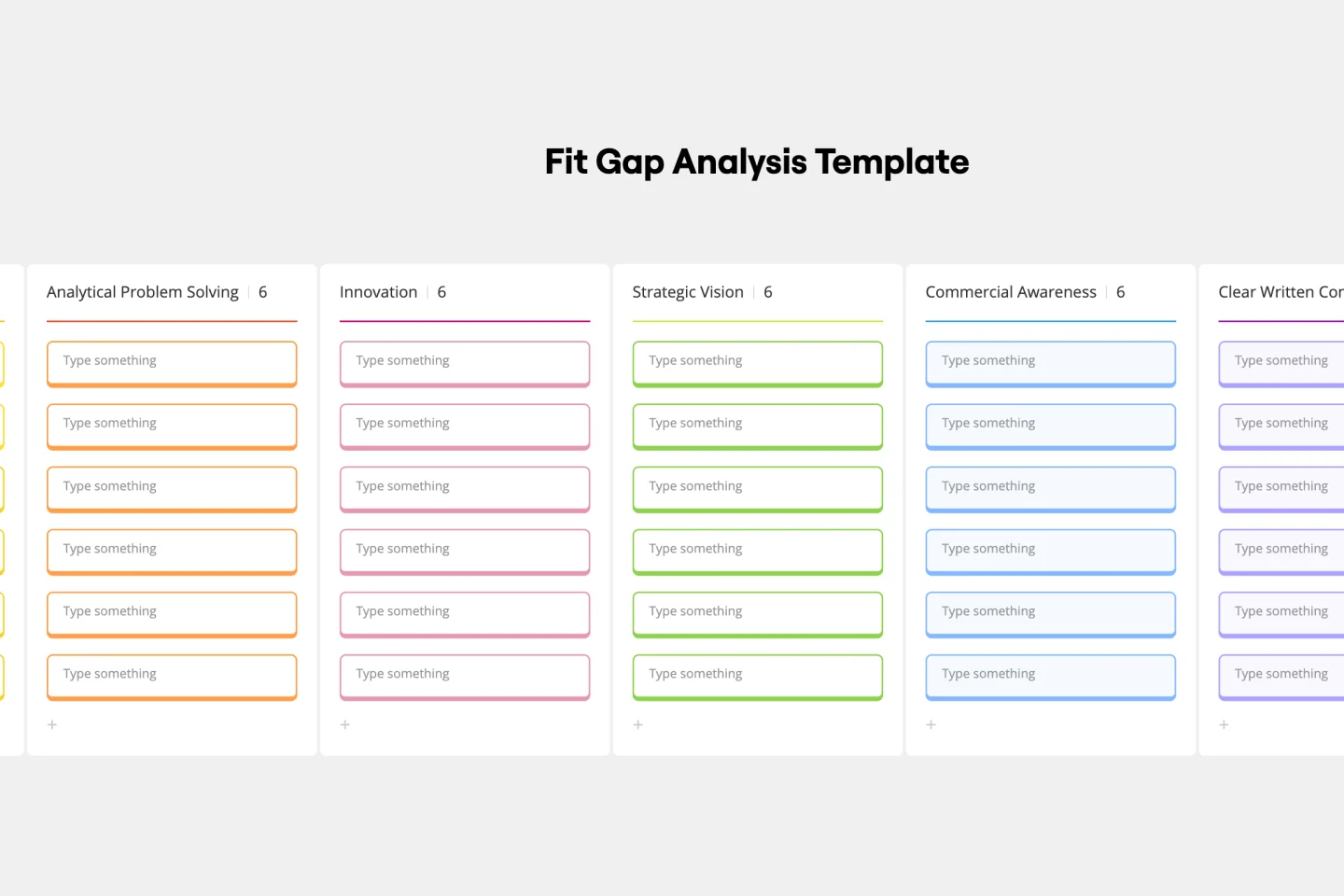
Fit Gap Analysis Template
The Fit Gap Analysis Template is a strategic tool designed to help teams and organizations identify discrepancies between their current state and desired outcomes. By visualizing these gaps, it offers a clear roadmap for improvement, allowing for a focused alignment of resources. One significant benefit of using this template is enhanced clarity; teams can visually discern where they currently stand and plot a precise path toward their goals, ensuring efficient decision-making and effective resource allocation.
Plus Delta Template

Plus Delta Template
The Plus Delta template is a simple but powerful tool for collecting constructive criticism from a group. The format encourages you and your team to focus on what went well, what you should repeat in the future, and what you should aim to change. To complete a Plus Delta template, simply make note of things that are working and things you would like to improve. You can then file these elements into two separate columns. Use Plus Delta to showcase wins and learnings for your team, stakeholders, employees, and bosses.
Target Market Decision Chart
Tier List Template
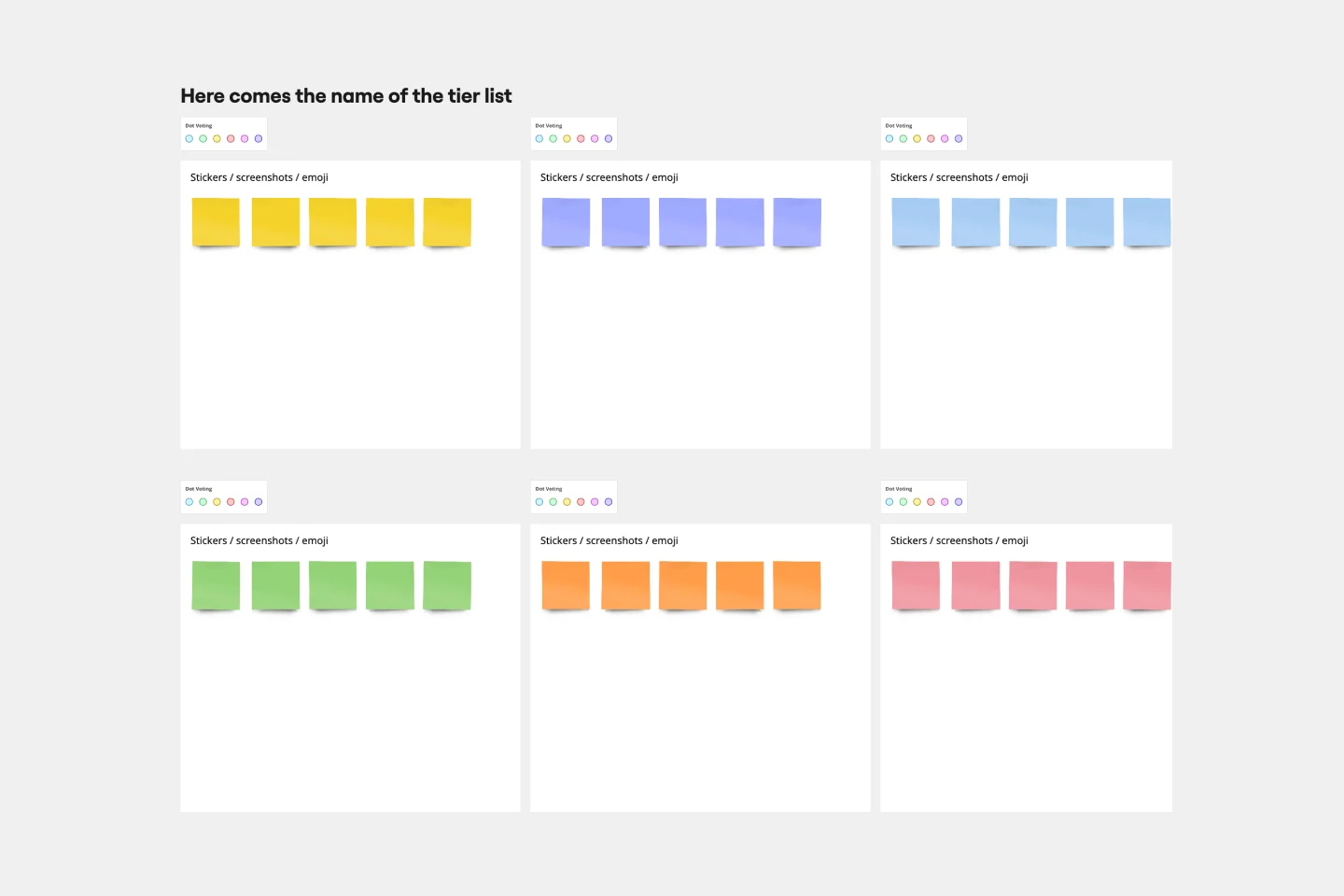
Tier List Template
A Tier List Template is a ranking tool that allows teams to organize different items into specific categories, or "tiers," based on their significance, quality, or performance. This template is a visual tool that aids in making decisions and prioritizing tasks. Use it to power your brainstorming, strategic meetings, and planning.
Oneday Cold Outreach Decision Map
Cost-Benefit Analysis Template

Cost-Benefit Analysis Template
With so many day-to-day decisions to make—and each one feeling high-stakes—it’s easy for all the choices to weigh a business or organization down. You need a systematic way to analyze the risks and rewards. A cost benefit analysis gives you the clarity you need to make smart decisions. This template will let you conduct a CBA to help your team assess the pros and cons of new projects or business proposals—and ultimately help your company preserve your precious time, money, and social capital.
SAFe Roam Board

SAFe Roam Board
A SAFe ROAM Board is a framework for making risks visible. It gives you and your team a shared space to notice and highlight risks, so they don’t get ignored. The ROAM Board helps everyone consider the likelihood and impact of risks, and decide which risks are low priority versus high priority. The underlying principles of SAFe (Scaled Agile Framework) are: drive cost-effective solutions, apply systems thinking, assume that things will change, build incrementally, base milestones on evaluating working systems, and visualize and limit works in progress.
Collaborative Decision-Making Tool
T-Chart Template
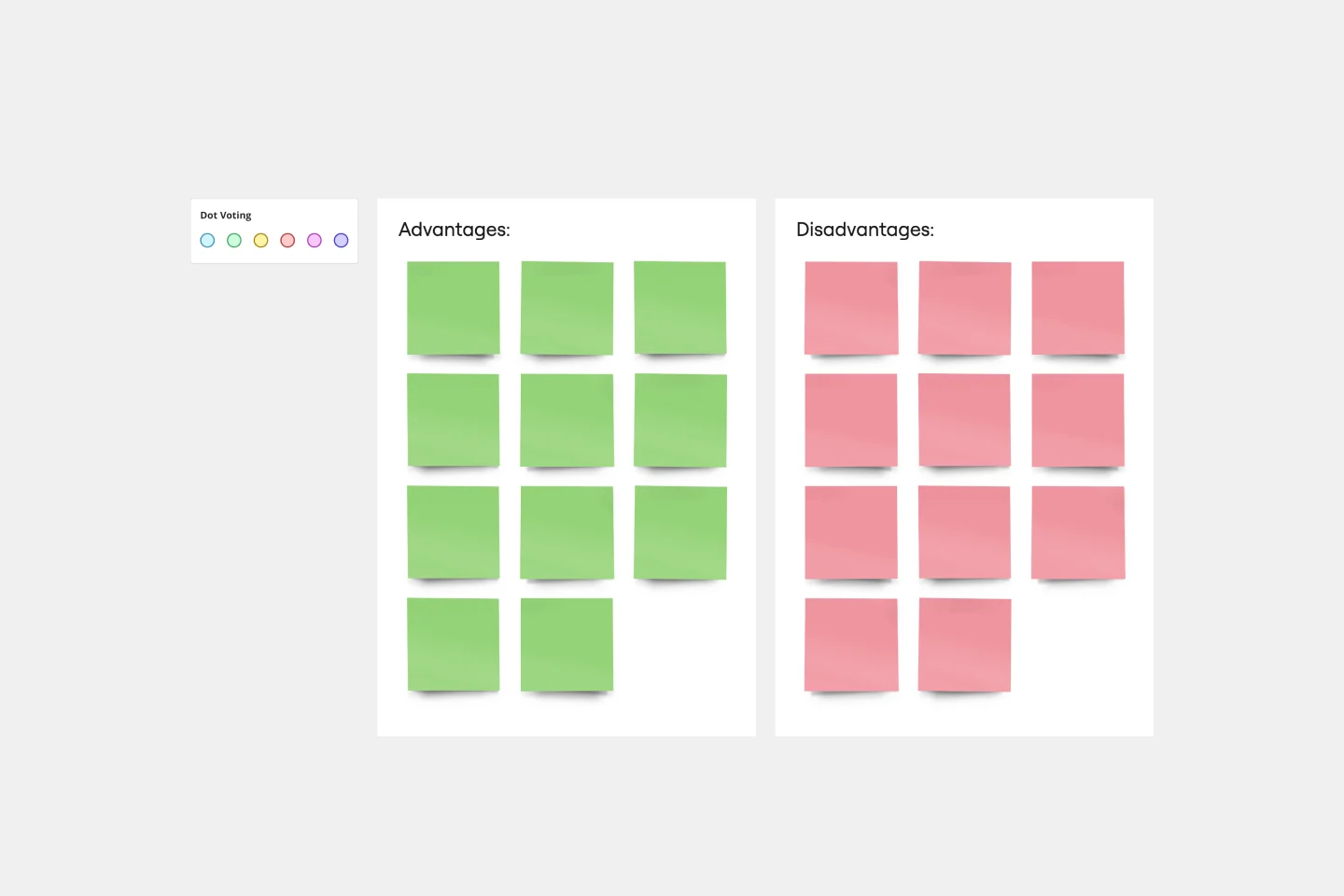
T-Chart Template
T-Charts can help you compare and contrast two different ideas, group information into different categories, and prove a change through “before” and “after” analysis. T-Charts are visual organizational tools that enable you to compare ideas, so you can evaluate pros and cons, facts and opinions, strengths and weaknesses, or big-picture views versus specific details. Designers and content creators can use T-Charts to turn possibilities into actionable ideas. T-Charts are useful for discussing differences and similarities with your team or clients and can help you to reach a decision together.
Force Field Analysis Decision Making Tool
Decision Making Tools
Cynefin Framework Template

Cynefin Framework Template
Companies face a range of complex problems. At times, these problems leave the decision makers unsure where to even begin or what questions to ask. The Cynefin Framework, developed by Dave Snowden at IBM in 1999, can help you navigate those problems and find the appropriate response. Many organizations use this powerful, flexible framework to aid them during product development, marketing plans, and organizational strategy, or when faced with a crisis. This template is also ideal for training new hires on how to react to such an event.
Look Mock Analyze Template

Look Mock Analyze Template
Doing your homework (aka, the research) is a key step in your design process, and the Look, Mock, Analyze approach helps you examine, structure, and streamline that step. With this powerful tool you’ll be able to identify your strengths and weaknesses, what you did right or wrong, and whether you spent time efficiently. Our Look, Mock, Analyze template makes it so easy for you to discover inspiration, mock up designs, and get feedback — you can start by setting up your board in less than a minute.
Explore more
About the Decision-Making Templates Collection
Miro's decision-making templates are designed to streamline and improve the decision-making process for teams of all sizes. These templates provide structured frameworks that help teams navigate complex decisions, ensuring that all relevant factors are considered and that the decision-making process is transparent and collaborative. Whether you're looking for a decision framework template, a template for decision-making, or a decision-making process example, Miro's collection has you covered.
Why you'll love our decision-making templates
Using Miro's decision-making templates offers numerous benefits:
Improved collaboration: These templates facilitate real-time collaboration, allowing team members to contribute their insights and perspectives, leading to more informed decisions.
Structured process: The templates provide a clear and structured approach to decision-making, ensuring that all necessary steps are followed and nothing is overlooked.
Time efficiency: These templates save time by providing a predefined framework, which would otherwise be spent setting up the decision-making process from scratch.
Improved clarity: Visualizing the decision-making process helps in identifying potential issues and understanding the rationale behind each decision.
Consistency: Using a standardized template ensures that the decision-making process is consistent across different projects and teams.
How to use the decision-making templates in Miro
Select a template: Choose a decision-making template from Miro's extensive library. You can browse through various options and select the one that best fits your needs.
Customize the template: Once you've selected a template, customize it to suit your specific decision-making context. Add or remove sections, adjust the layout, and input relevant data.
Invite team members: Share the template with your team members and invite them to collaborate. Miro's real-time collaboration features allow everyone to contribute simultaneously.
Define the decision criteria: Clearly outline the criteria that will be used to evaluate the options. This ensures that everyone is on the same page and understands the basis for the decision.
Brainstorm and evaluate options: Use the template to brainstorm potential options and evaluate them against the defined criteria. Encourage team members to provide their input and discuss the pros and cons of each option.
Make the decision: After evaluating the options, use the template to document the final decision and the rationale behind it. This provides a clear record that can be referred to in the future.
Implement and review: Once the decision is made, implement the chosen option.
Monitor progress: After implementing the decision, use the template to track the progress and outcomes. This helps in ensuring that the decision is executed as planned and allows for adjustments if necessary.
Gather feedback: Collect feedback from team members on the decision-making process and the outcome. This can provide valuable insights for future decisions and help refine the templates.
Reflect and improve: Periodically review the decision-making process and the effectiveness of the templates. Identify areas for improvement and update the templates accordingly to better suit your team's needs.
Miro's decision-making templates empower teams to make informed, efficient, and collaborative decisions. By providing a structured framework, these templates help teams navigate complex decisions with clarity and consistency.









